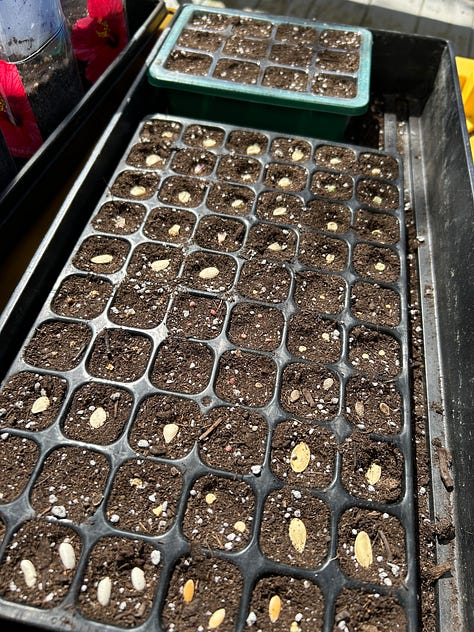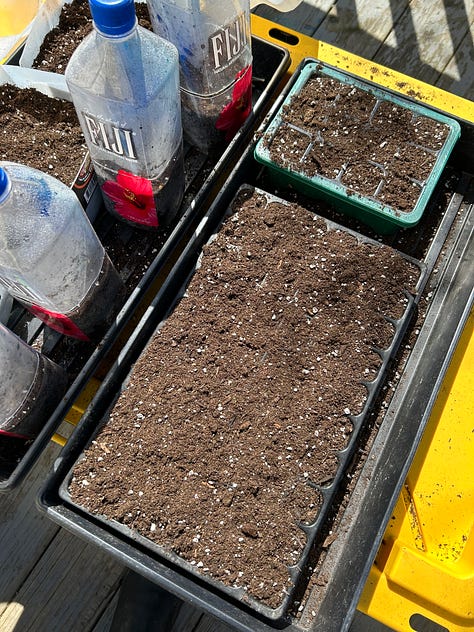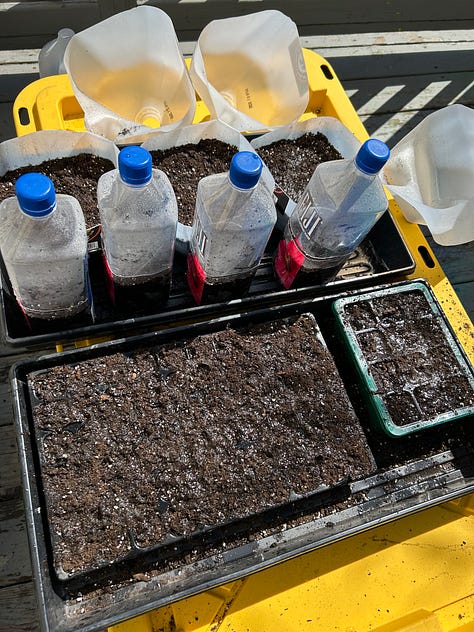I approach gardening with a mixture of paranoia and optimism. Paranoia in the sense that every year I decide that something is about to go terribly wrong with the “food system”, and the harvest capacity of our backyard is the only thing that stands between our family and starvation. Considering that this mindset has, in various places at various times, kept families alive through lean winters, I don’t consider it to be problematic.
What is problematic is my optimism - a sort of enthusiastic giddiness that grips me at the beginning of each planting season, leading me to push past the boundaries of sound advice and time-tested gardening methods, and into the territory of wanton experimentation.
For example, last year I built garden beds: 10’x4’ frames made of hemlock 2x12’s. I read a bit about hugelkultur, a gardening method that involves planting into mounds of gradually decaying wood. We were removing a few large trees behind our yard, so I asked the arborist to leave us the chipped branches. These are considered “ramial” wood, a mix of small branches and green leaves particularly good for hugelkultur, due to the relatively high nitrogen content, which makes it decompose more quickly then trunk wood.
The goal is to not put too much un-decomposed wood in too-close proximity to plant roots, because the wood will steal nitrogen from the plants in order to decompose, and the plants will suffer. I had read this, but I decided to “push it” nonetheless, reasoning that the higher nitrogen levels in the ramial wood chips would mitigate the situation. Covering eight inches of wood chips with a few inches of a compost/soil mixture, I planted it in and was both surprised and disappointed when the kale, arugula, peas, garlic, leeks and cucumbers all failed. The potatoes and tomatoes were sort of ok. The only thing that thrived was the Asian eggplant and a fall crop of saffron crocus.
This year, I resolved early on to play it by the book, keeping in mind the advice of gardeners such as Huw Richards and Charles Dowding. I set up my camera and recorded myself sowing the planting trays. Still, the experimental giddiness took over, and before I knew it, I was sowing 6 to 10 seeds in each 1-inch square planting cell, thinking “If Dowding recommends sowing 2 seeds, certainly a few more won’t be a problem!” Additionally, I gleaned the seeds from my growing library of several-years-old seed packets, which I am reluctant to throw away, reasoning that many of them are bound to sprout, and I will never know if I don’t try.
A creeping sense of unease kept me from editing the video, feeling that - while I’m comfortable jeopardizing my own yields, influencing others to do the same feels, somehow, irresponsible.
So I re-watched one of Dowding’s sowing videos, bought a set of new seeds, and consulted Dowding’s booklet, New Energies for Gardening, to determine the best time to plant. Two days before the full moon, I assembled my materials and proceeded thus:
First, I put an organic potting soil mixture into the seed trays and the recycled plastic bottle greenhouses. To make these, I poked four holes, with a scissor, in the bottom of each milk jug, and four holes at the very bottom of the sides of the water bottles (the bottoms were too hard). I do not cut them all the way around, which allows the tops to stay on, but still be open-able. I made a chart for the seed tray, marking what seed is in each cell.
Using the chart as a guide, I placed one or two seeds in each cell, depending on size of the seed.



Then I pressed each seed down so that its surface was at soil level, covered the trays with about 1/4 inch of soil and gently watered it in. To do this I used filtered water (concerned that the chlorine in our tap water may not be good for the seeds) in a bottle, holding my fingers across the top to sprinkle water onto the soil, being careful not to apply enough water to dislodge the smaller seeds from their cells.
Then I set the seed trays in front of a south-facing window. I might put the bottle-greenhouses outside, after giving them another watering or two.
I’ve still allowed myself room for experimentation, planting several cells with corn, peas and carrots, which is explicitly marked NOT RECOMMENDED! on the seed packets. I will also direct-sow each of these seeds outside, and see which approach is better.
To the wood-chip-rich planting beds, I will add a layer of several inches of pure compost (probably horse manure from a local rescue-horse farm, which I have been told I may come and get for free). A bigger project will be last season’s experimental greenhouse, whose wire roof collapsed under a load of snow while we were away for two weeks in February. That I intend to dismantle, and once I do, I will have to come up with a plan for the experimental trough of goldfish that have been hibernating there all winter.









